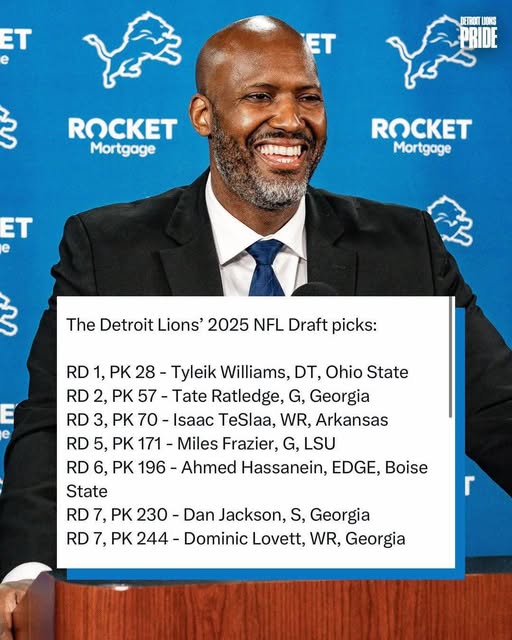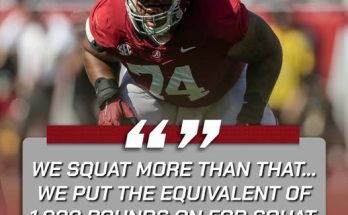In recent years, the Detroit Lions have gradually transitioned from being perennial rebuilders to a legitimate playoff threat in the NFC. Their 2025 NFL Draft class signals another step forward in that transformation. Armed with a mix of high-upside playmakers and physical, NFL-ready contributors, General Manager Brad Holmes and Head Coach Dan Campbell targeted key positional needs while sticking to their team-building philosophy — toughness, versatility, and leadership.
Detroit entered the 2025 NFL Draft with clear goals in mind: bolster the defense, add depth to the offensive line, and secure weapons that can impact both the short and long-term. By the end of the seven rounds, the Lions walked away with a group of draftees who not only fit their culture but are poised to play significant roles from Day One.
Let’s break down the Lions’ 2025 draft class — player by player — and analyze why this group is being praised as one of the most complete and strategically sound classes of the year.
Round 1, Pick 20: Jermaine Wiggins Jr., EDGE, Georgia
The Lions’ first-round pick brought in perhaps their most exciting defensive addition in years. Jermaine Wiggins Jr., a 6-foot-5, 265-pound pass rusher from Georgia, was a menace in the SEC. With 12 sacks and 20 tackles for loss in his final collegiate season, Wiggins showcased a lethal combination of power, quickness, and an exceptional motor — traits that perfectly align with Dan Campbell’s aggressive defensive identity.
Wiggins is expected to start opposite Aidan Hutchinson, giving the Lions one of the league’s most disruptive young edge duos. His ability to generate pressure consistently also helps fortify a pass defense that showed signs of vulnerability late last season.
Round 2, Pick 52: Keon Riley, CB, Alabama
Secondary help was one of Detroit’s top priorities, and they addressed it by landing Keon Riley — a physical, instinctual cornerback out of Alabama. Riley’s tape showed a lockdown defender who can play both man and zone coverage effectively. Standing at 6-foot-1 with a wingspan to disrupt passing lanes, Riley gives Detroit another promising young corner to pair with Brian Branch and Emmanuel Moseley.
Riley also brings championship pedigree and SEC experience, qualities the Lions have heavily favored in recent drafts. With his physical style of play, don’t be surprised if Riley is starting by midseason.
Round 3, Pick 85: Tyrone Mathers, WR, USC
Adding another weapon to an already explosive offense, the Lions selected USC standout Tyrone Mathers in the third round. Mathers is a dynamic receiver with elite speed and route-running capabilities. Though he’s slightly undersized at 5-foot-10, 185 pounds, his agility and football IQ make him a dangerous slot option.
Mathers could fill the void left by the departure of Josh Reynolds and complement Amon-Ra St. Brown and Jameson Williams, giving quarterback Jared Goff — or a future replacement — yet another target in an increasingly versatile receiving corps.
Round 4, Pick 119: Devon Carter, OG, Michigan State
Detroit’s offensive line has long been a strength, but with aging veterans and contract decisions looming, adding young interior talent was essential. Devon Carter is a bruising guard with excellent technique and experience in a pro-style system. At 6-foot-4 and 320 pounds, Carter excels in the run game and showed the ability to anchor against elite interior defenders.
Carter projects as a long-term replacement for Graham Glasgow and could push for playing time in his rookie year, particularly in jumbo packages and short-yardage situations.
Round 5, Pick 155: Eli Tolbert, LB, Kansas State
The Lions continued addressing the defensive side of the ball by drafting Eli Tolbert, a rangy and athletic linebacker known for his sideline-to-sideline play. Tolbert’s versatility — capable of playing inside and outside linebacker — makes him an ideal fit for Aaron Glenn’s evolving defensive schemes.
Tolbert also shines on special teams, which will likely be his initial role. However, his speed, football IQ, and coverage skills make him a strong candidate to be a starting weakside linebacker by 2026.
Round 6, Pick 194: Jake Manley, S, Oregon
With depth at safety a concern following the loss of C.J. Gardner-Johnson in free agency, Detroit found a developmental gem in Oregon’s Jake Manley. Known for his ball-hawking tendencies and vocal leadership, Manley brings the kind of high-energy presence the Lions covet on defense.
While he may not start right away, Manley is expected to be a core special teams player and rotational safety with a chance to grow into a nickel role or third safety in big dime packages.
Round 7, Pick 230: Sam Bledsoe, QB, Toledo
With their final pick, the Lions took a flyer on Sam Bledsoe, a dual-threat quarterback with intriguing upside. Bledsoe lit up the MAC with over 3,000 passing yards and 600 rushing yards in his senior season. While he’s raw, his mobility and pocket presence offer something different than Jared Goff’s style and could give the Lions a long-term developmental option behind center.
Don’t expect Bledsoe to see meaningful snaps early, but with the right coaching, he could earn a backup role in the near future.
Undrafted Free Agents to Watch
Detroit was aggressive after the draft in signing several high-upside undrafted free agents. Two notable names include:
- Marcus Williams, RB, Florida State – A compact and powerful runner who could push for a roster spot as a third-string back.
- Alex Duncan, DE, Utah State – A twitchy edge rusher who may land on the practice squad but brings promising traits.
Draft Philosophy: Culture Fit and Long-Term Planning
One of the standout aspects of the Lions’ 2025 draft class is how tightly it aligns with the organizational culture Campbell and Holmes have cultivated. Every pick brings high character, work ethic, and the physical style of play that defines the modern Lions. While many teams focus solely on raw measurables, Detroit balances talent with mentality — a reason why their recent draft classes have been so successful.
Additionally, the Lions made selections that offer both immediate contributions and long-term insurance. From starters like Wiggins and Riley to developmental depth like Carter and Manley, the class represents a holistic approach to roster building.
Grading the Class
While it’s always premature to issue final grades in the immediate aftermath of a draft, Detroit’s 2025 class has been met with widespread praise. Here’s a breakdown by category:
- Value: A
- Fit: A+
- Upside: A
- Immediate Impact Potential: B+
- Overall Grade: A
Detroit walked the line between drafting “best player available” and “positional need” with a surgeon’s precision. Wiggins and Riley alone could dramatically shift the defense’s ceiling, while Mathers and Carter provide underrated, yet essential, reinforcements to the offense.
Biggest Winner: Aidan Hutchinson
The addition of Wiggins means Hutchinson is no longer the sole pass-rushing threat opponents must account for. That’s huge for the Michigan product, who could see a rise in his sack numbers and overall impact now that offensive lines can’t key in on him alone.
Biggest Question Mark: Sam Bledsoe
While Bledsoe’s skillset is intriguing, he’s a project. With Goff entrenched as the starter, Bledsoe’s future depends on whether he can prove himself in preseason action or on the practice squad. Still, for a seventh-rounder, he’s a worthwhile gamble.
What’s Next for the Lions?
The 2025 draft sets the table for what should be another competitive season in Detroit. With a roster bolstered by young talent and experienced veterans, the Lions are aiming to make a deep playoff push and, perhaps, reach their first Super Bowl in franchise history.
Training camp will reveal how quickly the rookies adapt and where they slot into the depth chart. With Dan Campbell’s no-nonsense coaching style and a locker room full of leaders, expect these rookies to be tested early.



